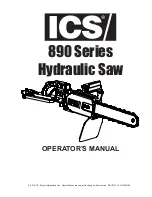
14
63
64
16
65
66
14
30
30
30
62
65
64
63
3-8mm
1
2
48
35
67
16
English
Fig. 6a
Fig. 6b
Fig. 7a
◌
Unplug the saw.
◌
Turn height adjustment knob clockwise to raise blade to maximum height.
◌
Remove the table insert.
◌
Set the saw blade angle to 0° and raise the saw blade to the uppermost position.
◌
Remove the blade wrenches from storage area.
Remove the blade:
◌
Using one opened-ended blade wrench (14), place the flat open end on the flats
on the inner blade flange (62).
◌
Using the other opened-ended blade wrench (14), place the flat open end on
the flats on the arbor nut (64). Holding both wrenches firmly, pull the opened-
ended blade wrench on the arbor nut (64) forward to the front of the machine.
◌
Remove arbor nut (64), outer blade flange (65), saw blade (30) and ring (66).
◌
Lower the saw blade to lowest position and replace table insert.
◌
Unplug the saw.
◌
Set the blade angle to 0°.
◌
Raise the saw blade to maximum height by turning height adjusting knob
clockwise.
◌
Lock the blade by turning bevel lock lever clockwise.
◌
Place the riving knife in the highest position.
◌
Pull out and hold knob (67) and push anti-kickback pawls up, remove it from
the anti-kickback pawls storage (35) located on inside of the left side of saw.
(Fig. 7a)
REMOVING AND INSTALLING THE BLADE (Fig. 6a-6b)
CAUTION:
Check the arbor hole diameter of the blade before installing the blade. Always use the correct ring for the arbor hole of the
blade you intend to use.
CAUTION:
To work properly, the saw blade teeth must point down toward the front of the saw. Failure to heed this instruction could
cause damage to the saw blade, the saw or the workpiece.
WARNING:
Make sure that the saw blade is installed to rotate in the proper direction. Do not use grinding wheels, wire brushes, or
abrasive wheels on a table saw. Improper saw blade installation or use of accessories not recommended may cause
serious injury.
CAUTION:
The ring 30 mm in outer diameter is factory-installed onto the arbor.
WARNING:
The large, flat surface of the outer blade flange faces the saw
blade and the saw blade (30) is firmly seated against the inner
blade flange (62).
WARNING:
The saw blade (30) should be aligned with the riving knife (16)
and ensuring there is a gap of 3 to 8 mm between the blade teeth
and the riving knife (16).
WARNING:
If the inner blade flange has been removed, reinstall it before
placing the saw blade on arbor. Failure to do so could cause an
accident.
WARNING:
Be extremely careful when loosening arbor nut. Keep firm grasp
on both wrenches. Do not allow hands to slip and contact blade.
WARNING:
Make sure the anti-kickback pawls are reinstalled immediately
after finishing any non-through cut operations which require their
removal.
WARNING:
Replace dull or damaged anti-kickback pawls. Dull or damaged
anti-kickback pawls may not stop a kickback, increasing the risk
of serious personal injury.
WARNING:
Only use a 254 mm diameter blade. To avoid injury from an accidental start, make sure the switch is in the OFF position
and the plug is not connected to the power source outlet.
WARNING:
Be extremely careful when loosening arbor nut. Keep firm grasp on both wrenches. Do not allow hands to slip and contact
blade.
ANTI-KICKBACK PAWLS INSTALLATION (Fig. 7a-7b)
Anti-kickback pawls should only be installed for through cuts.
Install the blade:
◌
Place the ring (66) and one new blade on arbor (63). Make sure saw blade teeth
point down at the front side of saw table. Place outer blade flange (65) and arbor
nut (64) on arbor and use blade wrenches to tighten nut securely.
DO NOT
over
tighten.
















































